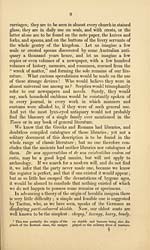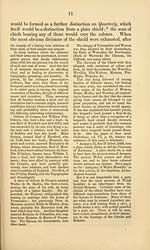Notices of the Ellises of England, Scotland, and Ireland, from the conquest to the present time
(350) Page 346
Download files
Complete book:
Individual page:
Thumbnail gallery: Grid view | List view

10
paly, quarterly, gyronny, &c. are the bearings of some of the
oldest European families ; the first in the noblest colours, or
and azure, being the bearing of the ancient and princely
house of Vermandois. These coats precisely answer to
the description of Tacitus ; and knowing the tendency in
human nature, to transmit from father to son a symbol or
name that had become honourable, what is more natural, more
likely, more in accordance with universal usage, than that
these simple family distinctions, known to be borne by noble
houses at least in the eleventh century, should be the here-
ditary family badges, displayed on the shields of warrior
chieftains among the Teutonic tribes, and transmitted with
sacred reverence to their sons and grandsons ? And what
would be so easy, so simple, and so natural as the formation
of the great majority of the ancient coats by succeeding gene-
rations, as the branches of a family increased, new conquests
were made, and alliances entered into ? 8 In this way Gyronny
According to Snorro Sturleson, Magnus
Berfetta, son of Olaf Kyrre, who became
king of Norway, A. D. 1093, bore when
he invaded Ireland, gules a lion or on his
shield and surcoat (Ency. Metr.) In the
Pictorial History of England (i, 139) is
an engraving from a plate in Sir S.
Meyrick's 'Ancient Costume of the British
Islands' of a design taken by him from
some Danish horns of gold. It consists
of two warriors with shields, one with
a spear and shield : the latter exhibiting a
star of seven points ; the other has a
sword, but the face of his shield is
averted ; on his surcoat, over his chest,
is a star. The Picts and other barbarians
painted their bodies, probably in the same
parti-coloured way as the Germans did
their shields.
8 Every topographer, genealogist, and
herald, has entertained the feudal theory
of the formation of derivative coats ; no
one has hitherto ventured to affirm or
suspect that the feudal connection had
nothing to do with the origination of a
new coat of arms. Yet investigation
repudiates this long and universally preva-
lent notion, as indeed might, at any time,
a priori reasoning on the objects and
extent of the feudal relationship. For
every topographer well knows that a
tenant in capite was frequently sub-
tenant to one or more tenants in capite ;
that sub-tenants, who were not tenants in
capite, held of different chiefs in different
counties ; that by marriage, sale, forfeiture,
and exchange, fiefs, both large and small,
constantly changed hands, much more fre-
quently than is generally thought. How,
then, could the tenant be said to have
adopted his coat armour from his feudal
lord ? Whose, of two or more chiefs,
was he to imitate ? Many arms are com-
pounded, it is true, and therefore are
derived from more than one source ; but
the great majority of those of the early
periods are simple and unchanged, in the
chief line, for generations. Theoretically,
then, it will be seen, this mode of deriving
armorial bearings could not have been
carried out ; and the actual practice of
the times, as ascertained by investigation,
at once refutes this long cherished theory,
and proves to be what, theoretically would
be pronounced to be the simplest and
most explanatory, viz., a derivation by
family relationship. The feudal connec-
tion was a coincidence, not the cause ; in
the time of the Conqueror, as appears
by Doomsday, a nearly invariable coinci-
dence, a great baronial proprietor of course
sub-infeudating his sons and sons-in-law
in preference to strangers ; subsequently,
in the time of Henry III, as appears
by the Testa de Nevill, a rarer coincidence,
from the changes that a century and a
half had produced ; so that it will be
found, in that monarch's time, few of
paly, quarterly, gyronny, &c. are the bearings of some of the
oldest European families ; the first in the noblest colours, or
and azure, being the bearing of the ancient and princely
house of Vermandois. These coats precisely answer to
the description of Tacitus ; and knowing the tendency in
human nature, to transmit from father to son a symbol or
name that had become honourable, what is more natural, more
likely, more in accordance with universal usage, than that
these simple family distinctions, known to be borne by noble
houses at least in the eleventh century, should be the here-
ditary family badges, displayed on the shields of warrior
chieftains among the Teutonic tribes, and transmitted with
sacred reverence to their sons and grandsons ? And what
would be so easy, so simple, and so natural as the formation
of the great majority of the ancient coats by succeeding gene-
rations, as the branches of a family increased, new conquests
were made, and alliances entered into ? 8 In this way Gyronny
According to Snorro Sturleson, Magnus
Berfetta, son of Olaf Kyrre, who became
king of Norway, A. D. 1093, bore when
he invaded Ireland, gules a lion or on his
shield and surcoat (Ency. Metr.) In the
Pictorial History of England (i, 139) is
an engraving from a plate in Sir S.
Meyrick's 'Ancient Costume of the British
Islands' of a design taken by him from
some Danish horns of gold. It consists
of two warriors with shields, one with
a spear and shield : the latter exhibiting a
star of seven points ; the other has a
sword, but the face of his shield is
averted ; on his surcoat, over his chest,
is a star. The Picts and other barbarians
painted their bodies, probably in the same
parti-coloured way as the Germans did
their shields.
8 Every topographer, genealogist, and
herald, has entertained the feudal theory
of the formation of derivative coats ; no
one has hitherto ventured to affirm or
suspect that the feudal connection had
nothing to do with the origination of a
new coat of arms. Yet investigation
repudiates this long and universally preva-
lent notion, as indeed might, at any time,
a priori reasoning on the objects and
extent of the feudal relationship. For
every topographer well knows that a
tenant in capite was frequently sub-
tenant to one or more tenants in capite ;
that sub-tenants, who were not tenants in
capite, held of different chiefs in different
counties ; that by marriage, sale, forfeiture,
and exchange, fiefs, both large and small,
constantly changed hands, much more fre-
quently than is generally thought. How,
then, could the tenant be said to have
adopted his coat armour from his feudal
lord ? Whose, of two or more chiefs,
was he to imitate ? Many arms are com-
pounded, it is true, and therefore are
derived from more than one source ; but
the great majority of those of the early
periods are simple and unchanged, in the
chief line, for generations. Theoretically,
then, it will be seen, this mode of deriving
armorial bearings could not have been
carried out ; and the actual practice of
the times, as ascertained by investigation,
at once refutes this long cherished theory,
and proves to be what, theoretically would
be pronounced to be the simplest and
most explanatory, viz., a derivation by
family relationship. The feudal connec-
tion was a coincidence, not the cause ; in
the time of the Conqueror, as appears
by Doomsday, a nearly invariable coinci-
dence, a great baronial proprietor of course
sub-infeudating his sons and sons-in-law
in preference to strangers ; subsequently,
in the time of Henry III, as appears
by the Testa de Nevill, a rarer coincidence,
from the changes that a century and a
half had produced ; so that it will be
found, in that monarch's time, few of
Set display mode to:
![]() Universal Viewer |
Universal Viewer | ![]() Mirador |
Large image | Transcription
Mirador |
Large image | Transcription
Images and transcriptions on this page, including medium image downloads, may be used under the Creative Commons Attribution 4.0 International Licence unless otherwise stated. ![]()
| Histories of Scottish families > Notices of the Ellises of England, Scotland, and Ireland, from the conquest to the present time > (350) Page 346 |
|---|
| Permanent URL | https://digital.nls.uk/95549813 |
|---|
| Description | A selection of almost 400 printed items relating to the history of Scottish families, mostly dating from the 19th and early 20th centuries. Includes memoirs, genealogies and clan histories, with a few produced by emigrant families. The earliest family history goes back to AD 916. |
|---|

